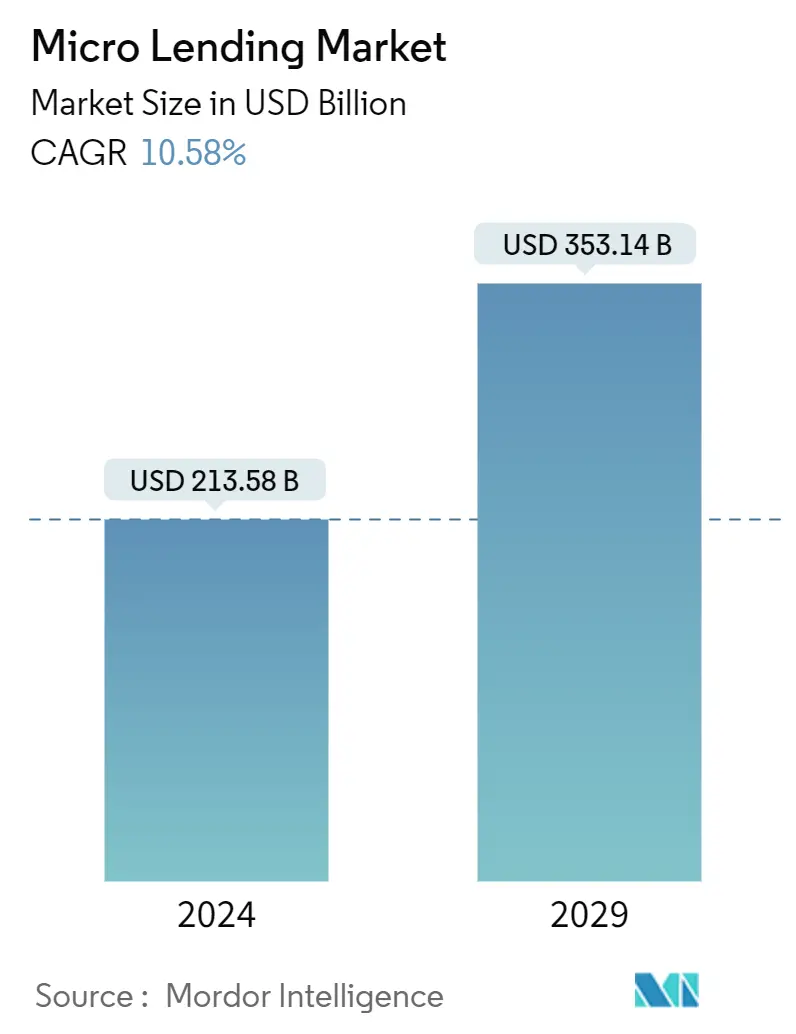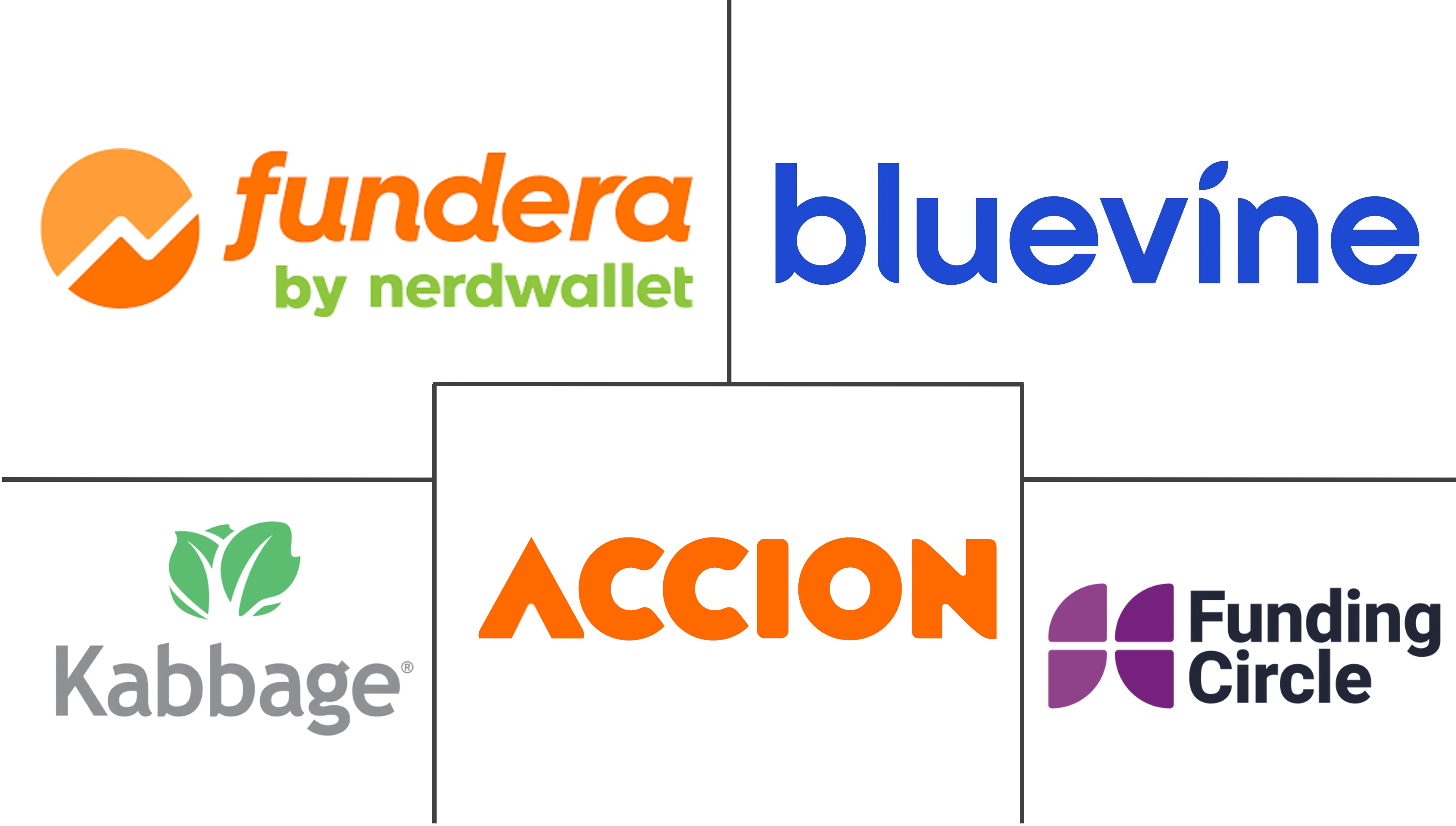Market Size of Micro Lending Industry

| Study Period | 2020-2029 |
| Market Size (2024) | USD 213.58 Billion |
| Market Size (2029) | USD 353.14 Billion |
| CAGR (2024 - 2029) | 10.58 % |
| Fastest Growing Market | North America |
| Largest Market | Asia Pacific |
Major Players
*Disclaimer: Major Players sorted in no particular order |
Micro Lending Market Analysis
The Micro Lending Market size is estimated at USD 213.58 billion in 2024, and is expected to reach USD 353.14 billion by 2029, growing at a CAGR of 10.58% during the forecast period (2024-2029).
Microlending is growing due to the rapid adoption of digital technology. The industry is expected to benefit significantly from better connectivity in developing countries and technical progress in several countries in the Middle East & Africa. The extensive integration of sophisticated technology across developing nations, such as mobile banking, ATMs, POS systems, and others, is paving the way for future market opportunities in the industry. For example, the Government of India uses the Adhar payment bridge system to provide microloans and various other services to citizens nationwide.
The expansion of the micro-lending industry is also positively impacted by the increased ability of entrepreneurs to start new businesses with less financial support. However, the industry is expected to benefit financially from introducing advanced technologies in microfinance.
The market's growth is expected to be driven by technological innovations and various technologies, such as AI, to reduce the costs of companies associated with microloan applications. The increasing digitalization and the growing use of smartphones and electronic wallets have made it easier for borrowers to repay loans. These digital trends are expected to create new growth opportunities for the market over the next few years.
Micro Lending Industry Segmentation
Microlending is one of the most common types of microfinancing. It is a very small loan given to a person to help them start their own business or to help them expand their business. The micro lending market is segmented by service provider, end user, and geography. By type, the market is segmented into banks, microfinance institutes (MFI), and NBFC (non-banking financial institutions). By end user, the market is segmented into small enterprises, solo entrepreneurs, and micro-entrepreneurs, and by geography, the market is segmented into North America, Europe, Asia-Pacific, the Middle East & Africa, and South America. The report offers the market size in value terms in USD for all the abovementioned segments.
| By Type | |
| Banks | |
| Microfinance Institute (MFI) | |
| Non-Banking Financial Institutions (NBFC) |
| By End User | |
| Small Enterprises | |
| Solo Entrepreneurs | |
| Micro Entrepreneuers |
| By Geography | |
| North America | |
| Europe | |
| Asia-Pacific | |
| Middle East & Africa | |
| South America |
Micro Lending Market Size Summary
The micro lending market is experiencing significant growth, driven by the rapid adoption of digital technologies and improved connectivity in developing regions, particularly in the Middle East and Africa. The integration of advanced technologies such as mobile banking and electronic payment systems is creating new opportunities for the industry. This growth is further supported by the increasing ability of entrepreneurs to start businesses with minimal financial support and the introduction of technologies like AI to streamline loan applications and reduce costs. The rise in digitalization, along with the widespread use of smartphones and electronic wallets, is facilitating easier loan repayments, thereby opening up new avenues for market expansion.
In the Asia-Pacific region, micro lending has seen substantial growth due to the presence of numerous small and medium-sized enterprises (SMEs) that drive economic activity. These SMEs are increasingly seeking tailored financial services to support their growth, prompting microlending institutions to provide small loans for expansion and essential investments. The expanding middle class in the region is also contributing to the demand for consumer credit, with microlenders offering flexible loan products to meet the needs of middle-income borrowers. The market is moderately fragmented, with key players like Accion International and BlueVine Inc. employing various strategies to target SMEs and entrepreneurs, further fueling the sector's development.
Micro Lending Market Market Size - Table of Contents
-
1. MARKET DYNAMICS
-
1.1 Market Overview
-
1.2 Market Drivers
-
1.2.1 Increasing Interest in Socially Responsible Investment Driving Market Growth
-
1.2.2 Advancement in Mobile Banking and Digital Platform Driving Market Growth
-
-
1.3 Market Restraints
-
1.3.1 Shutdown of Small and Medium Businesses During COVID-19 Pandemic
-
-
1.4 Market Opportunities
-
1.4.1 Increasing Number of Small Entrepreneurs
-
1.4.2 Increasing Venture Capital Firm Investments for Micro Lending
-
-
1.5 Industry Attractiveness: Porter's Five Forces Analysis
-
1.5.1 Threat of New Entrants
-
1.5.2 Bargaining Power of Buyers/Consumers
-
1.5.3 Bargaining Power of Suppliers
-
1.5.4 Threat of Substitutes
-
1.5.5 Intensity of Competitive Rivalry
-
-
1.6 Insights on Government Initiatives in the Micro Lending Market
-
1.7 Impact of COVID-19 on the Market
-
-
2. MARKET SEGMENTATION
-
2.1 By Type
-
2.1.1 Banks
-
2.1.2 Microfinance Institute (MFI)
-
2.1.3 Non-Banking Financial Institutions (NBFC)
-
-
2.2 By End User
-
2.2.1 Small Enterprises
-
2.2.2 Solo Entrepreneurs
-
2.2.3 Micro Entrepreneuers
-
-
2.3 By Geography
-
2.3.1 North America
-
2.3.2 Europe
-
2.3.3 Asia-Pacific
-
2.3.4 Middle East & Africa
-
2.3.5 South America
-
-
Micro Lending Market Market Size FAQs
How big is the Micro Lending Market?
The Micro Lending Market size is expected to reach USD 213.58 billion in 2024 and grow at a CAGR of 10.58% to reach USD 353.14 billion by 2029.
What is the current Micro Lending Market size?
In 2024, the Micro Lending Market size is expected to reach USD 213.58 billion.

